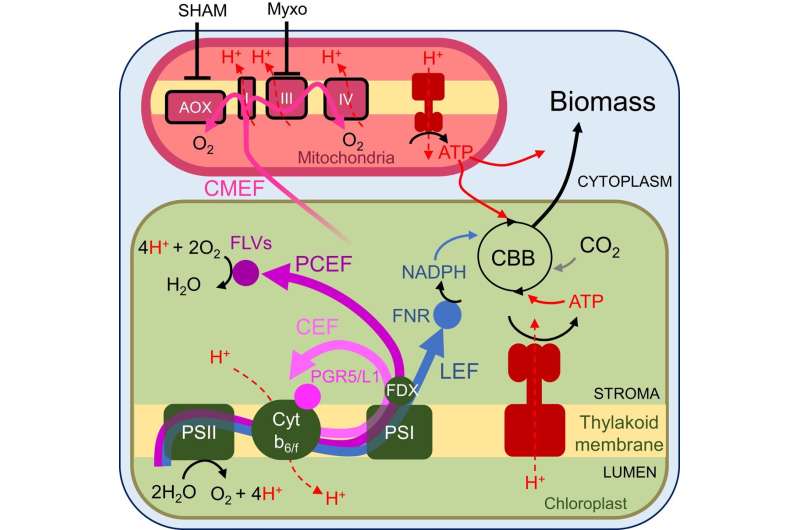This article has been reviewed according to Science X's editorial process and policies. Editors have highlighted the following attributes while ensuring the content's credibility:
fact-checked
peer-reviewed publication
trusted source
proofread
Photosynthesis powers our world, but what fuels this fundamental process?

It's hard to overstate the importance of photosynthesis, the biochemical pathway by which plants, algae, and certain bacteria convert the sun's energy into the organic material that feeds the entire living biosphere. But there are still aspects of the photosynthetic function that scientists are working to understand. Expanding their knowledge could help improve agriculture and fight climate change.
Photosynthesis provides the foundation for life on Earth by making our atmosphere oxygen rich; it also sequesters carbon pollution from human activity and forms the basis of the food chain.
"On a molecular level, photosynthesis has two components," explained Carnegie Science algae expert Adrien Burlacot. "There's the sunlight-powered splitting of water molecules, which produces the energy molecules that are used by all cells, and the fixation of carbon dioxide from the atmosphere into organic material, or biomass, which consumes chemical energy."
He added, "But there's a disconnect that has caused decades of debate. This is because the chemical energy needed to power the second half of this process—the transformation of carbon dioxide into biomass—is different than the energy currency created by splitting water molecules. And the processes involved in converting the basic energy molecules into the energy used to synthesize sugars are still mysterious."
When it comes to photosynthetic efficiency, organisms have wide variation in their capacity to transform sunlight into biomass. While a tree or a grass would typically be able to use between 0.5% and 1% of the sun's energy, microalgae are able to use up to 5% of that energy.
"Photosynthesis in plants is very inefficient," Burlacot added. "Because algae are much better at it, they hold important potential for understanding how to improve this fundamental process that underpins nearly every aspect of life on our planet."
Part of the secret lies in algae harboring a special biochemical system for concentrating carbon dioxide within the photosynthetic apparatus. For the last couple of years, Burlacot's lab has been investigating how algae power this carbon-concentrating ability by studying Chlamydomonas, a group of photosynthetic algae that are found around the globe in fresh and saltwater, moist soils, and even at the surface of snow.
Recently, they expanded this to examine how the basic energy currency is converted to the chemical energy necessary for the carbon-fixation process itself in algae.
In their paper published in The Plant Cell, Burlacot's team revealed that three biochemical energy circuits power carbon fixation in Chlamydomonas. Their work demonstrated that all three pathways can sustain high rates of sugar production. However, the three circuits were not all equally efficient.
"Two out of three pathways are wasting twice more energy than the most efficient one," Burlacot said. "And—interestingly—the two most efficient pathways are not present in crop plants."
Looking ahead, the group wants to elucidate the contributions of each of the three mechanisms and to build connections between these and similar pathways in other photosynthetic organisms. A big question remains on whether differences in photosynthetic efficiency between species could be related to the energy circuits that they are using.
"We are attempting to understand biochemical and biophysical steps of how algae capture carbon dioxide, which could enable us to improve the efficiency of important crop plants and to enhance carbon capture solutions," Burlacot concluded. "More work is needed, and we are revealing the full story of how carbon fixation is fueled."
More information: Gilles Peltier et al, Alternative electron pathways of photosynthesis power green algal CO2 capture, The Plant Cell (2024). DOI: 10.1093/plcell/koae143
Journal information: Plant Cell
Provided by Carnegie Institution for Science




















